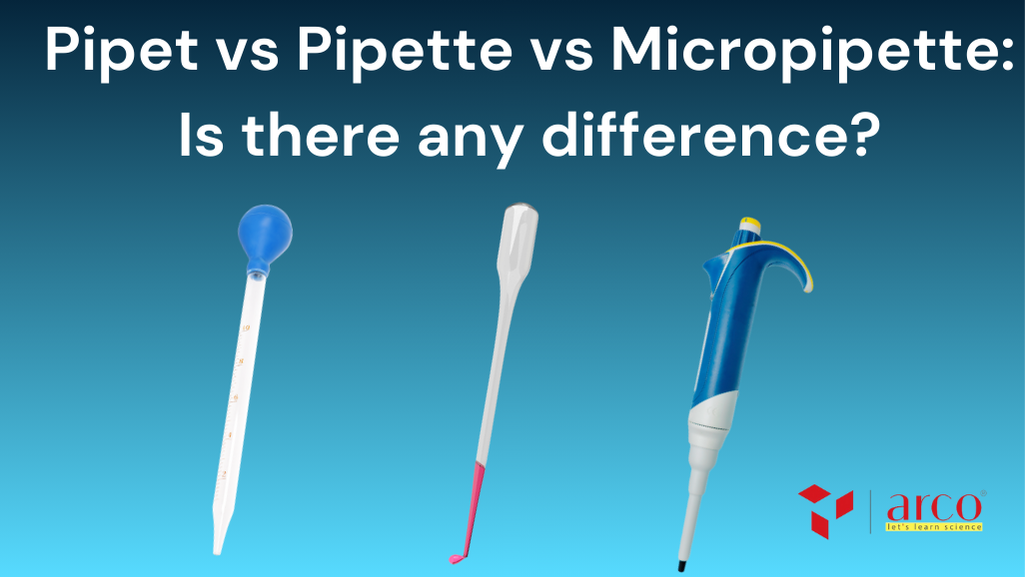Pipet vs Pipette vs Micropipette: Is there any difference?
Summary: In the lab, the words “pipet,” “pipette,” and “micropipette” are often used to refer to the same thing, but they mean different tools for handling liquids precisely. This blog has everything you need to know about the various kinds of pipettes, what a micropipette is, and more. Also, find out why choosing the right one can have such a significant effect on your studies.
Key Takeaways
- Pipet, pipette, and micropipette are all synonyms for tools used to move liquids, but they are not of the same size, accuracy, or purpose.
- Pipette is more common outside the US, while pipet is more common in the US.
- For those unfamiliar with pipette pronunciation, it is typically pronounced as “pih-PET”.
- Micropipettes are made to work with tiny amounts, usually in microliters.
In scientific research, especially with regard to liquid handling, accuracy is absolutely vital. Although the terms pipet vs pipette and micropipette might seem to be identical, they relate to instruments with different uses for which they were created. Pipettors— mechanical tools used to run pipettes—add even another degree of accuracy to liquid handling chores. Knowing these variations can help you guarantee that your results are dependable and increase the accuracy of your studies if you work in a lab. Thus, is there a genuine difference between a pipet, pipette, and micropipette?
What is a Pipet?
The first term to consider is pipet, commonly considered the American version of pipette. A pipet is a laboratory device to transfer liquids from one container to another in a predetermined amount. The device usually takes the form of a long, thin tube that uses vacuum suction to function. Additionally, a wide range of pipet sizes and types are available, but the most important thing to remember is that these tools are helpful in measuring liquids accurately.
Common Types of Pipet
- Volumetric pipetes: These are set to give a fixed amount of liquid and are helpful for precise measurements.
- Serological Pipets: These are graduated pipets that can move different amounts of fluids. They’re usually used for bigger amounts.
- Pasteur Pipets: Glass pipets without markings on them are Pasteur Pipets. They are usually helpful in moving small amounts of liquid.
People in the US may use the word “pipet” more often, but “pipette” is usually used instead. However, the type of tool used—a volumetric pipet, a serological pipet, or something else—depends on how precise the experiment needs to be.
What is a Pipette?
The word “pipette” is used more often outside the United States, especially in British English. About pipette pronunciation: It is typically pronounced as pih-PET, with emphasis on the second syllable. The pronunciation is the same regardless of the regional spelling (pipet or pipette).
A pipette is a lab tool, like a pipet, used to correctly move small amounts of liquid from one place to another. Also, the shape and purpose of pipettors are the same as a pipet, and the words often refer to the same thing. So, what makes it different?
The Science Behind the Name: The word “pipet” in French, which is where the name “pipette” comes from, means “small pipe.” Over the years, the tool has become an important part of lab work, especially in biology, chemistry, and medicine.
Different Types of Pipette
- Single-Channel Pipettes:These tools often move precise, predetermined amounts of liquid accurately. Additionally, you can get them with a set or changeable volume.
- Multi-channel pipettes: These equipment are great for filling many wells on a plate at once and are useful in high-throughput tests.
- Electronic pipettes: Lastly, electronic pipettes are a modern take on hand pipettes. Batteries drive them and make dispensing liquid easier for the user by doing it automatically.
What is a Micropipette?
Let us now specifically address micropipettes. You have heard of this instrument if you work in a lab, particularly in molecular biology or biochemistry. Usually, in the microliter range (µL), a micropipette is a particular kind of pipette which measures and transfers very small quantities of liquid. Furthermore, these are vital for jobs needing great accuracy, such as DNA analysis, protein counting, and cell culture.
Characteristics of a Micropipette
- Volume Range: Usually handling amounts between 0.1 µL and 1000 µL, micropipettes are perfect for studies where even the smallest measurement error might provide erroneous findings.
- Adjustability: Mostly including changeable volume settings, most micropipettes let users choose a certain liquid amount to transmit. This gives them adaptability for many uses.
- Disposable Tips: Using disposable plastic tips, micropipettes guarantee sterility and stop sample cross-contamination.
The following are examples of typical laboratory micropipette sizes:
| Micropipette Sizes | Volume Range |
| p2 | 0.2-2 μL |
| p10 | 1-10 μL |
| p20 | 2-20 μL |
| p100 | 20-100 μL |
| p200 | 20-200 μL |
| p1000 | 100-1000 μL |
Pipet vs Pipette —which one is correct?
First, to be clear and answer your question straight, a pipet and a pipette are the same thing. The main difference between them is regional preference:
- Pipette: The more common term in British English.
- Pipet: The more common term in American English.
Differences Between Pipet, Pipette, and Micropipette
Pipet, pipette, and micropipette first are synonyms for the same instrument. And in some measure, they do. Here, nevertheless, are the slight variations:
Context of Use:
- Though pipet is the American spelling and pipette is more frequent in other areas, pipet and pipette are the same.
- However, the micropipette is especially an instrument for handling microliter volumes and is usually helpful in very exact scientific processes.
Volumes Range:
- Depending on the kind, pipets and pipettes usually measure more from a few milliliters (mL) up to 50 mL or more.
- Usually between 0.1 µL and 1000 µL, micropipettes—used in jobs demanding more accuracy—are for tiny amounts.
Design:
- Pipets and pipettes range in design from primary tubes to more sophisticated variants with digital readouts; they can be either manual or electronic.
- Highly specialized micropipettes can include ergonomic elements to improve accuracy and lower hand strain during repeated work.
Using:
- From wide range general liquid transfer to more specific investigations requiring exact volume measurements, pipets and pipettes find use everywhere.
- Conversely, any job involving minute liquid transfers—such as processing DNA, RNA, or protein samples—requires micropipettes.
Which One Should You Choose?
It would help if you chose a pipete, micropipette, or pipette based on the lab work you need to do. A normal pipete or pipette will work fine with significant amounts of liquid. On the other hand, a micropipette is the best tool for studies that use very small or exact amounts of liquid, especially in the microliter range.
To sum up quickly, here it is:
- A pipette or pipette is best for amounts greater than 1 mL, especially for everyday jobs requiring more significant amounts of liquid.
- For amounts less than 1 mL, a micropipette is the best tool for the job because it gives you the accuracy you need for molecular biology or chemistry research.
Final Thoughts
People use the words “pipet” and “pipette” to refer to the same type of lab tool. The micropipette is different because it can handle much smaller amounts more accurately. Therefore, knowing the difference between these tools can help you make better choices and ensure your studies are as accurate as possible.
Lastly, if you want to measure liquids precisely and accurately, having the right tool can make all the difference. You’ll know exactly what you need the next time you reach for a pipet, pipette, or micropipette!

